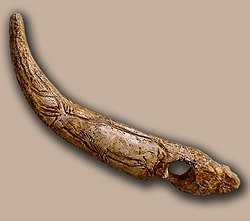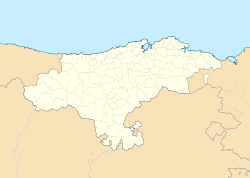Cueva del Castillo | |
 Main room | |
location in Spain | |
| Alternative name | Cave of the Castle |
|---|---|
| Location | Puente Viesgo (Cantabria), Spain |
| Coordinates | 43°17′32″N 3°57′55″W / 43.29222°N 3.96528°W |
| Type | Cave |
| Part of | Caves of Monte Castillo |
| Official name | Monte Castillo - El Castillo |
| Type | Cultural |
| Criteria | i, iii |
| Designated | 1985 (9th session) |
| Part of | Cave of Altamira and Paleolithic Cave Art of Northern Spain |
| Reference no. | 310-009 |
| Region | Europe and North America |
| Official name | Cueva del Castillo |
| Type | Non-movable |
| Criteria | Monument |
| Designated | 25 April 1924 |
| Reference no. | RI-51-0000267 |
The Cueva del Castillo contains both a decorated cave and an archaeological site, within the complex of the Caves of Monte Castillo, in Puente Viesgo, Cantabria, Spain.

The archaeological stratigraphy has been divided into around 19 layers, depending on the source they slightly deviate from each other, however the overall sequence is consistent, beginning in the Proto-Aurignacian, and ending in the Bronze Age.[citation needed]
El Castillo was discovered in 1903 by Hermilio Alcalde del Río, a Spanish archaeologist, who was one of the pioneers in the study of the earliest cave paintings of Cantabria. The entrance to the cave was smaller in the past and has been enlarged as a result of archaeological excavations. Alcalde del Río found an extensive sequence of images executed in charcoal and red ochre on the walls and ceilings of multiple caverns.[citation needed].
The authors of the first monograph (H. Alcalde del Rio, H. Breuil, L. Sierra, Les cavernes de la région cantabrique (Espagne), Monaco, 1911) catalogued about 200 motifs.
In 2012, uranium-thorium datings on discs of the cave have given dates older than 40,000 years.[1] This could be consistent with the tradition of cave painting originating in the Proto-Aurignacian, with the first arrival of anatomically modern humans in Europe.[2] These results are still subject to debates.[3]
A 2013 study of finger length ratios in Upper Paleolithic hand stencils found in France and Spain determined that the majority were of female hands, overturning the previous widely held belief that this art form was primarily a male activity.[4]
Numerous attempts have been made to determine an individual's sex based on the Manning index.[5] According to this study, the ratio between the length of the index finger and the ring finger indicates a difference between the two sexes (approximately 1 for women and 0.9 for men). This ratio, calculated on current populations, has been applied to Palaeolithic negative handprints. However, the validity of anthropological methods is now debated by many researchers,[6] which means that this type of approach must be treated with caution.
In their complete study of the cave (2003-2023), Marc & Marie-Christine Groenen have identified 2,698 motifs and archaeological evidence, among them 541 figurative motifs (475 animals, 3 composite animals, 21 humans, 1 composite human, 1 imaginary creature, 40 projectiles), 924 non figurative motifs (834 elementary tracings, 90 complex tracings), 884 marks, 84 handprints, 118 archaeological evidence and 17 lithophones.[7]
See also
[edit]References
[edit]- ^ Pike, A. W. G.; Hoffmann, D. L.; Garcia-Diez, M.; Pettitt, P. B.; Alcolea, J.; De Balbin, R.; Gonzalez-Sainz, C.; de las Heras, C.; Lasheras, J. A.; Montes, R.; Zilhao, J. (14 June 2012). "U-Series Dating of Paleolithic Art in 11 Caves in Spain". Science. 336 (6087): 1409–1413. Bibcode:2012Sci...336.1409P. doi:10.1126/science.1219957. PMID 22700921. S2CID 7807664.. "We present uranium-series disequilibrium dates of calcite deposits overlying or underlying art found in 11 caves, including the United Nations Educational, Scientific, and Cultural Organization (UNESCO) World Heritage sites of Altamira, El Castillo, and Tito Bustillo, Spain. The results demonstrate that the tradition of decorating caves extends back at least to the Early Aurignacian period, with minimum ages of 40.8 thousand years for a red disk, 37.3 thousand years for a hand stencil, and 35.6 thousand years for a claviform-like symbol. These minimum ages reveal either that cave art was a part of the cultural repertoire of the first anatomically modern humans in Europe or that perhaps Neanderthals also engaged in painting caves." The El Castillo red stippled disk (sample O-83) was dated to 41.40±0.57 ka (95% CI, corrected). Table 1: Ages are corrected for detritus by using an assumed 232Th/238U activity of 1.250±0.625 and 230Th/238U and 234U/238U at equilibrium. See also: Callaway, Ewen (14 June 2012). "Spain claims top spot for world's oldest cave art : Nature News & Comment". Nature. Nature.com. doi:10.1038/nature.2012.10838. Retrieved January 19, 2017.
- ^ "If the earliest cave paintings appeared in the region shortly before 40.8 ka, this would, assuming that the Proto-Aurignacian cultural complex was made exclusively by Homo sapiens, support the notion that cave art coincided with their arrival in western Europe ~41.5 ka and that the exploration and decorating of caves was part of their cultural package. However, because the 40.8-ky date for the disk is a minimum age, it cannot be ruled out that the earliest paintings were symbolic expressions of the Neanderthals, which were present in Cantabrian Spain until at least 42 ka." (Pike et al. 2012, p. 1412).
- ^ White, R., G. Bosinski, R. Bourrillon, J. Clottes, M.W. Conkey, S. Corchón Rodriguez, M. Cortés Sánchez, M. de la Rasilla Vives, B. Delluc, G. Delluc, V. Feruglio, H. Floss, P. Foucher, C. Fritz, O. Fuentes, D. Gárate, J. González, M. González Morales, M. González Pumariega Solis, M. Groenen, J. Jaubert, E. Man-Estier, M.A. Martinez Aguirre, M. Medina Alcaide, O. Moro Abadia, R. Ontañón, P. Paillet, S. Petrognani, R. Pigeaud, G. Pinçon, F. Plassard, S. Ripoll, O. Rivero, É. Robert, A. Ruiz Redondo, J.F. Ruiz López, C. San Juan-Foucher, J.L. Sanchidrián Torti, G. Sauvet, M.D. Simón Vallejo, G. Tosello, P. Utrilla, D. Vialou et M.D. Willis 2019a. Still no archaeological evidence that Neandertals created Iberian cave Art. Journal of Human Evolution 144 : 102640 (doi.org/10.1016/j.jhevol.2019.102640).
- ^ Snow, Dean R. (2013). "Sexual Dimorphism in European Upper Paleolithic Cave Art" (PDF). American Antiquity. 78 (4): 746–761. doi:10.7183/0002-7316.78.4.746. JSTOR 43184971.
- ^ Manning, J.T., D. Scutt, J. Wilson and D.I. Lewis-Jones 1998. The ratio of 2nd to 4th digit length: a predictor of sperm numbers and concentrations of testosterone, luteinizing hormone and oestrogen. Human Reproduction 13: 3000-3004.
- ^ Voracek, M. 2009. Why digit ratio (2D:4D) is inappropriate for sex determination in medicolegal investigation. Forensic Science International 185 : 29-30; Brůžek, J., M. Lázničková-Galetová, P. Galeta et J. Maestracci 2010-2011. Les empreintes de mains dans l’art pariétal : possibilités et limites d’interprétations mises en relief par l’anthropologie médico-légale, in J. Clottes (dir.) L’art pléistocène dans le monde. Actes du Congrès IFRAO (Tarascon-sur-Ariège, septembre 2010) : 1197-1206; Galeta, P., J. Brůžek and M. Lázničková-Galetová 2014. Is sex estimation from handprints in prehistoric cave art reliable? A view from biological and forensic anthropology. Journal of Archaeological Science 45: 141-149.
- ^ Marc, Groenen; Marie-Christine, Groenen (2025). La grotte ornée d’El Castillo. Archaeopress Archaeology. doi:10.32028/9781803279275. ISBN 978-1-80327-927-5.


